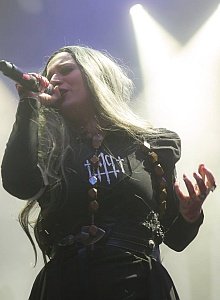Onmyo-Za - Kishi-Bojin
CD Info
2011
King Records / Japan
12 Tracks
Mostly Japanese Lyrics
To American listeners, the seemingly unpronounceable name of the Japanese band "Onmyo-za" might be reason enough to avoid listening to the band’s music. Also, the fact that the majority of their lyrics are written in Japan, the band’s native language, could also prove to be another stumbling block for prospective listeners. This is completely understandable to some extent, as many love music that contains understandable lyrics in one’s own language that makes the meaning of the song become more relatable to one’s life. Except, Onmyo-za’s music is brilliant enough to transcend any language barrier.
Surprisingly, Japanese rock or "Jrock" is not a completely unknown entity in the American music scene. For the past four years or so, the Japanese metal band "Dir En Grey," has toured multiple times in the USA. Additionally, one of Japan’s more legendary rock acts, X Japan, toured the states in late 2011, and Yoshiki, the drummer/pianist of the band, was even interviewed by ABC. Even with all this exposure in the states, the appeal of both bands is still limited to a niche fan-base.
Since ninth grade, I have been a big fan of Jrock. After first listening to X Japan’s dynamic sound, I was immediately hooked, regardless of the supposed language barriers. At the time, X Japan was my first taste of rock music at the time, and my love for the band has yet to wane. Combining both classical and rock compositions, the music was unlike anything that I’d heard before. In retrospect, I even saw this band as initially being the band that established my love for the genre of symphonic/alternative metal as a whole.
About three or four months ago, I started avidly searching for Jrock bands that featured a female vocalist. One of my search results on Youtube happened to be "Onmyo-za" (陰陽座)); the song was "Kouga Ninpouchou," which was featured as a theme song for the anime, Basilisk. My love for this band developed instantaneously. First off, Kuroneko, the main female vocalist, had a beautiful vibrato, and the strength of her voice contrasted nicely with the fierce sound of the thrumming guitars, and the restless drums. Upon first listening to the song, I envisioned the classical Japanese- anime scene, set within Feudal Japan, where samurais bravely fight one another to the death. It is reminiscent of the recurrent Viking theme that appears within some of the metal music from either Norway or Sweden. Essentially, Onmyo-za’s music is Japanese at its core.
Their newest album, Kishi-Bojin (鬼子母神)), maintains the essence of classical Japan that pervades their sound. Surprisingly, this album happens to be their eleventh studio album because the band is relatively popular within Japan. For example, Kishi-Bojin actually peaked in the Japanese music sales charts at #13, during the first week of its release.
From the outset of the album, the album consumes you and infuses your mind with an adventurous spirit. Unfortunately, I was unable to find any English lyric translations, so I was left trying to conjure images inspired by the music. For example, the second track (Samayoi) remarkably utilizes the infamous "Beauty and the Beast" vocal technique that helps shape the rich dynamic of the male and female vocalists that reoccurs throughout the album. The second track of the album seems to resemble a power struggle of sorts between the female vocalist (Kuroneko), and the male vocalist (Matatabi). In some ways, the song is comparable to Nightwish’s "I wish I had an Angel," and numerous other fine examples of metal tracks that feature both a female and male vocalist.
Astonishingly, the instrumental section is not segregated, or muted during the course of this track, or several of the other tracks featured on this CD. Instead, the band masterfully is able to bolster the sounds of the guitar or drum, and still strike a fine balance between the vocal and instrumental sections. There are sadly a myriad number of metal tracks that are unable to strike this balance without limiting the effect of either of these sections. For me, this impressive feat was the largest piece of the band’s appeal. Only several other bands such as "Epica," and a few others are equally skilled in allowing equal opportunity for both musical sections to have their moment to shine.
Another magnificent aspect of this album was the lack of discordant "grunting." Personally, I normally despise guttural vocals as a whole because they are used in lazy ways by many bands. While I can tolerate it in some of Epica’s tracks, I find that their biggest flaw within some of their tracks lies with the artless incorporation of Mark Jansen’s growls into the sound. Weirdly, it seems like some bands just feature these forgettable "growlers" to enhance the testosterone of a metal album that might have become too soft and effeminate by having female vocalist be the primary vocalist. Others use the "grunting," to just fill a supposed void within the sound, or distract listeners from deficits in the instrumental section.
Remarkably, the guttural vocals are used wisely within Onymo-za’s music to grant the listener a sense of the aura of war and adventure that weaves its way into their sound. In this album in particular, the guttural vocals are not fully-fleshed growls, but warrior chants. Instead of being an impediment to the sound, these harsh masculine vocals evoke the admirable resilience of these warriors. It also further contributes to the traditional Japanese aesthetics that are fundamental to this band. Fascinatingly, the members of this band often wear traditional kimonos during live performance to cement this romantic spirit of traditional Japan within the minds of listeners.
As a whole, the only flaw that my nitpicky self could pick up on was the remarkably similar guitar chords or music patterns that reappear in some of the tracks. Sometimes, this effect causes some of the tracks to sound suspiciously repetitious. Then again, there are enough marked differences within each track, so this does not become a problem that consumes the album. If you have ever craved for the Japanese equivalent of European folk metal music, you will probably really like this album. Personally, I wish that their music could find more international appeal as the band is seriously one of the finest examples of stellar Japanese metal.
9.5 / 10
Standout Tracks:
Track #2 (Samayoi), Track #4 (Namasu), Track #5 (Oni Kosae No Uta), Track #7 (Zakuro To Jubaku)


